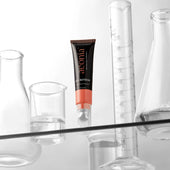Hyaluronic Acid Study: Gentle Serum
Hyaluronic Acid Study: Gentle Serum
1.0 OBJECTIVE:
A fibroblast cell culture model was used to assess the ability of the Aeonia Gentle Serum to exert an effect on hyaluronic acid synthesis.
2.0 Methods
2.1 Preparation of Fibroblasts
Fibroblasts were seeded into the individual wells of a 24-well plate in 0.5 ml of Fibroblast Growth Media (FGM) and incubated overnight at 37+2oC and 5+1% CO2. On the following day the media was removed via aspiration to eliminate any non-adherent cells and replaced with 0.5 ml of fresh FGM. The cells were grown until confluent, with a media change every 48 to 72 hours. Upon reaching confluency the cells were treated for 24 hours with DMEM supplemented with 1.5% FBS to wash out any effects from the growth factors included in the normal culture media. After this 24-hour wash out period the cells were treated with the test materials at the specified concentrations dissolved in FGM with 1.5% FBS. TGF-B (50 ng/ml) was used as a positive control for collagen and elastin, while 100 uM DbcAMP was used as a positive control for hyaluronic acid. Untreated cells (negative controls) just received DMEM with 1.5% FBS. The cells were incubated for 48 hours and at the end of the incubation period cell culture medium was collected and either stored frozen (-75°C) or assayed immediately. Materials were tested in triplicate.
2.2 Hyaluronic Acid Assay
A series of hyaluronic acid standards was prepared ranging from 50 ng/ml to 3,200 ng/ml. Next, 100 μl of each standard and sample was transferred to a well in an incubation plate. After adding 50 μl of detection solution to each well (except the reagent blank wells) the plate was incubated for 1±0.25 hour at 37±2°C. After the incubation, 100 μl of each sample/standard from the incubation plate was transferred to a corresponding well in the ELISA plate. The ELISA plate was covered and incubated for 30±5 minutes at 4°C and then washed three times with 300 μl of wash buffer. After the final wash 100 μl of enzyme solution was added to each well and the plate was incubated at 37±2°C for 30 ±5 minutes. After this incubation the wells were washed again as described above and then 100 μl of enzyme substrate solution was added to each well and the plate was incubated for 30-45 minutes at room temperature. After this final incubation 50 μl of stop solution was added to each well and the absorbance of the plate was measured at 405 nm using a plate reader.
3.0 Results
The results for the Hyaluronic Acid study can be found in Table 1 and Graph 1. These values are presented as mean concentration (ng/ml) ± the standard deviation of the mean.
4.0 Discussion
A fibroblast cell culture model was used to assess the ability of the Aeonia Gentle Serum to exert an effect on hyaluronic acid synthesis. The material was observed to significantly increase fibroblast hyaluronic acid production within this model.
Table 1. Hyaluronic Acid Assay Results

Graph 1. Hyaluronic Acid Assay Results

Disclaimer: This document is a summary of a Delavie Science's Gentle Serum study performed by an independent third-party testing facility. We believe the information provided here is correct but past performance is not necessarily indicative of future result








